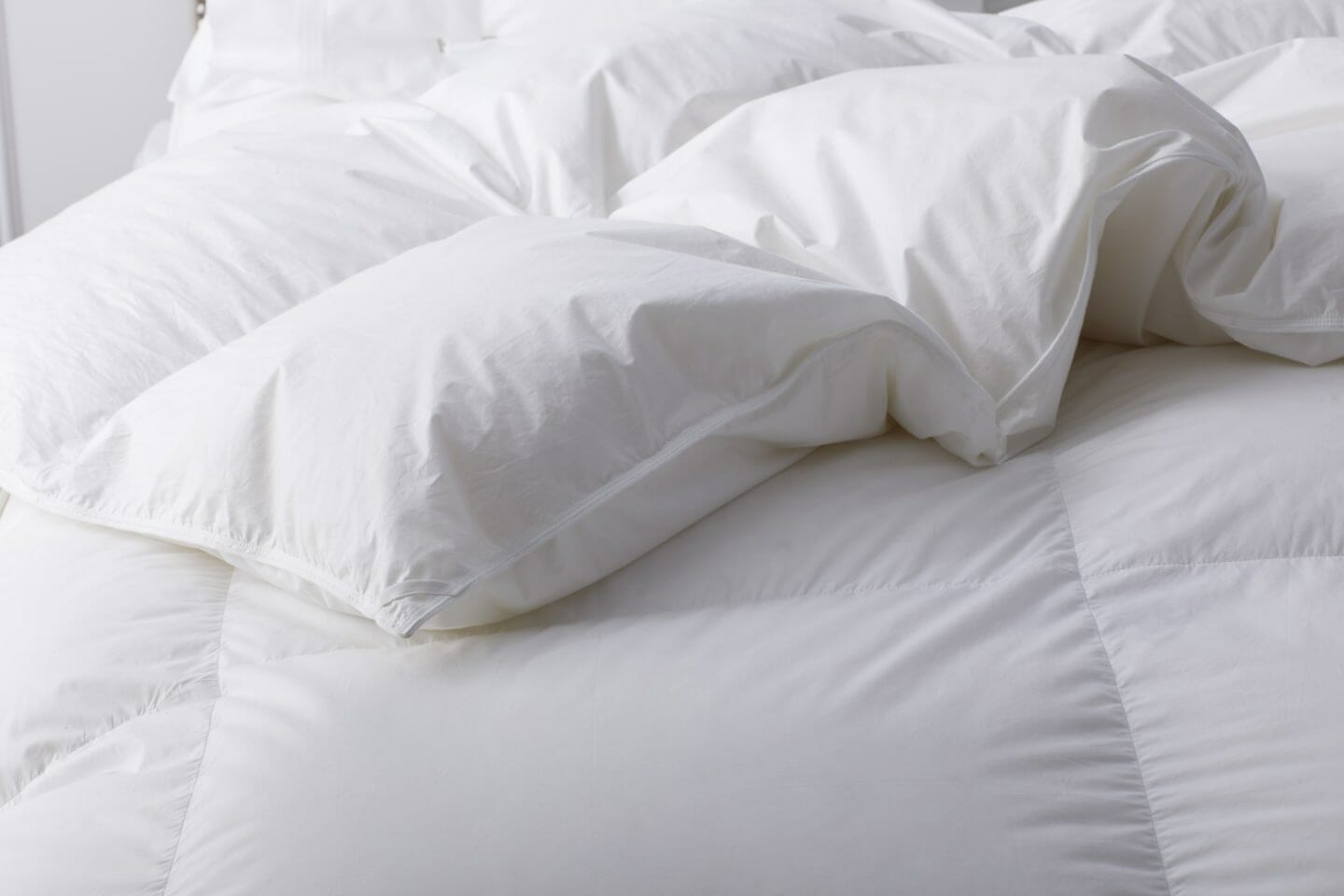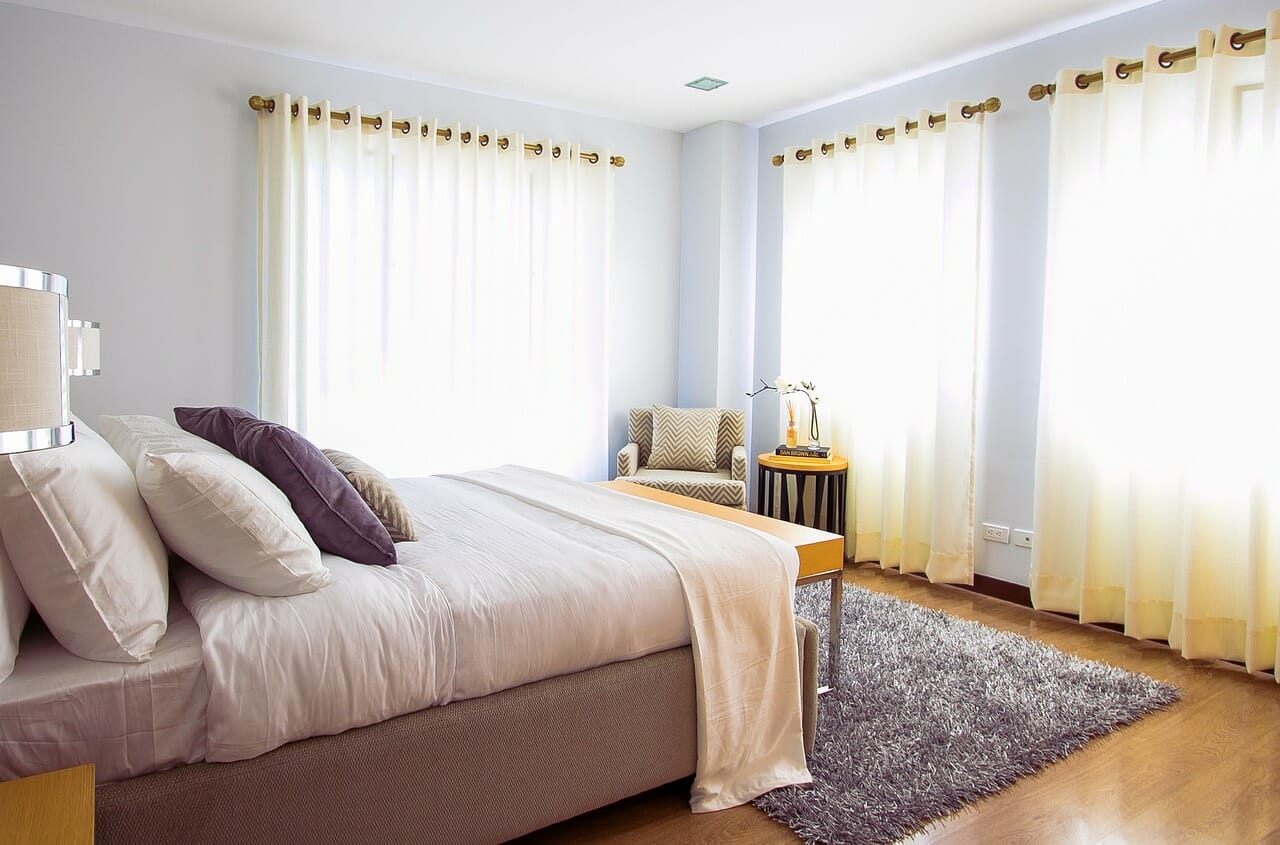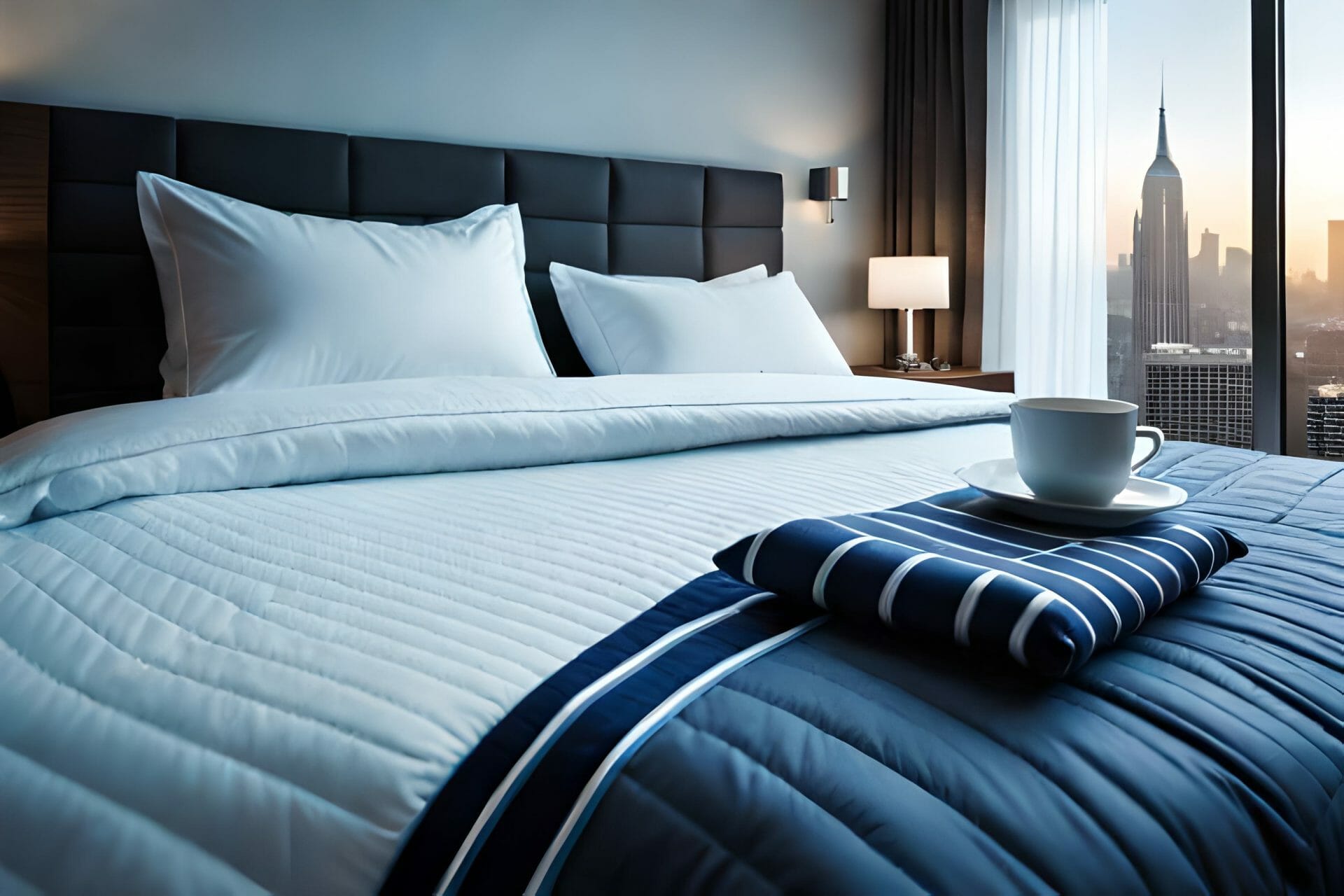When it comes to choosing the best material for a comforter, it’s essential to take into consideration a few vital factors. A comforter, akin to a duvet, is designed to provide warmth, comfort, and satisfaction to the user year-round. The fill weight is indicative of the level of insulation the comforter provides. If you tend to sleep hot, it is important to opt for a fill weight that won’t envelop your body heat, adding to your discomfort.
A popular material often used for comforters which is also both cool and comfortable is cotton, making it a good option for hot sleepers. Despite being slightly less breathable, synthetic materials are also a common choice for those who prefer a machine-washable comforter.
In essence, the quest to find the best comforter involves striking the perfect balance between warmth and breathability, between excess heat and staying cool. Selecting the right material for your new comforter will ensure that it keeps your body cool in summer and warm in winter, offering optimal comfort throughout the different seasons. Now, let’s delve into a deeper understanding of these materials.
Table of contents
Understanding Comforter Materials
Typically filled with insulative materials, a comforter is designed to keep you warm during cold nights while providing optimal comfort. It stands as one of the most vital items necessary for achieving restful sleep. With such responsibility resting on its shoulders (no pun intended), the make-up of your comforter becomes critical.
When choosing a comforter, it is important to consider both the material and the fabric. The material, such as cotton, polyester, down, or wool, affects the overall feel, breathability, and insulation of the comforter. On the other hand, the fabric, like cotton fabric, polyester fabric, or microfiber fabric, determines the appearance, texture, and aesthetic of the comforter. By paying attention to both the material and the fabric, you can ensure that you select a comforter that meets your personal preferences for comfort, style, and functionality.
Different types of materials offer varying benefits, the key lies in finding which aligns best with your needs.
Best Material for Comforter
Cotton: The All-Rounder
Cotton is renowned for its breathability and softness. It excels at wicking away moisture, making it an excellent choice for those who may tend to overheat at night or live in warmer climates. Plus, its easy maintenance adds to its appeal. Moving from cotton’s classic essence let’s explore the modern touch of polyester.
Polyester: The Practical Choice
Polyester, a synthetic material, is known for its remarkable durability and affordability, making it a commonly used fabric in various bedding components. It effectively resists wear and tear over time while offering the convenience of machine washability, which is a bonus for those seeking easy maintenance! Moving on from the practicality of polyester, let’s immerse ourselves in Down’s luxurious embrace.
Down: The Luxurious Insulator
For those seeking luxury combined with exceptional insulation properties, down material stands unmatched. This natural filling derived from duck or goose feathers presents unbeatable warmth and loftiness that oozes coziness, an indulgence worth considering! Having luxuriated in down’s warmth moving on let’s experience silk’s unique charm.
Silk: The Sensational Slumber
Silk brings forth an unmatched level of smoothness that glides effortlessly against your skin, a real treat! Moreover, this natural fiber boasts hypoallergenic properties alongside effective temperature regulation capabilities, an ideal choice for sensitive individuals seeking luxury paired with function. Having reveled in silk’s refined elegance now arrives bamboo’s eco-friendly allure.
Bamboo: The Sustainable Sleeper
Bamboo is an increasingly popular choice for comforter materials due to its sustainable credentials and impressive antimicrobial properties. It provides a clean sleeping environment while effectively wicking away moisture. Bamboo comforters are known for their softness and breathability, making them a welcoming option for hot sleepers.
Wool: The Natural Insulator
Wool comforters provide excellent insulation and are known for their ability to regulate body temperature. The natural fibers in wool trap heat during cold nights while allowing breathability to keep you comfortable. Wool is a durable material that offers long-lasting comfort and is suitable for those seeking a natural and sustainable option.
Now let’s shift gears from discussing what fills up our comforters to what envelops them, fabrics!
Best Fabric for Comforter
Cotton Fabric: The Classic Comfort
Cotton fabric echoes similar qualities as mentioned before, softness and breathability take center stage once again thus enhancing overall user comfort impressively! Leaving cotton behind we move towards another soft contender microfiber fabric.
Microfiber Fabric: The Soft and Durable
Microfiber fabric known widely for its soft texture also showcases commendable durability coupled with ease-of-care features that have made it a favorite among many households! Transitioning from microfiber’s practicality we venture into satin’s style domain.
Satin Fabric: The Elegant Touch
Satin fabric imparts not only a luxurious feel but also adds style points owing to its luminous sheen, an appealing factor if aesthetic considerations weigh high on your list. From satin’s glossy finish, we turn towards flannel’s hearty warmth.
Flannel Fabric: The Cozy Companion
Flannel stands out as an excellent choice if you live in colder climates due to the ample warmth and coziness it offers through even colder nights! Having felt flannel’s comforting embrace now enters silk fabric adding an extra dash of elegance.
Silk Fabric: The Natural Beauty
Representing elegance par excellence silk fabric offers natural softness aligned perfectly with temperature-regulating capabilities, a worthy consideration indeed!
Linen Fabric: The Strong and Breathable
Linen fabric is a top choice for comforters due to its strength, breathability, and durability. It keeps you cool in warm climates, ensuring a comfortable feel all night long. The natural texture of linen adds rustic charm to any bedroom decor. If you value durability and breathability, linen is an excellent option.
Next up: let’s uncover some crucial factors worth considering when choosing between these materials and fabrics!
Factors To Consider When Selecting Comforter Material And Fabric
The first aspect you should consider is your geographical location whether you live in the tropics or temperate zones would dictate different choices pertaining to comfy coverings!
For those prone to allergies or sensitivities certain options might prove better like hypoallergenic silk or antimicrobial bamboo!
Personal preferences play their part too! Whether you appreciate mother nature’s offerings more or lean towards synthetic creations, there are myriad options catering to every individual taste!
Finally, budget considerations cannot be overlooked while down depicts indulgence polyester serves practical pockets better!
Now, let’s dive into our expert opinions, recommendations, and comparisons, guiding you toward the perfect comforter choice.
Our Recommendation And Comparisons
According to our experience, cotton material is the most suitable for various sleeping preferences. Cotton is a breathable, soft, and easy-to-care-for material. It provides a cool feel in the summer and warmth in the winter. This material has excellent moisture-wicking properties, helping to maintain dryness and breathability throughout the night. Additionally, cotton is hypoallergenic, making it suitable for individuals with sensitive skin.
However, the choice of comforter material still depends on individual preferences and requirements. Some people may prefer the soft and lightweight feel of natural down, while others may prefer the cool and breathable properties of bamboo fabric. There are also those who may prefer the warmth and durability of wool material.
Therefore, when selecting the most suitable material for a comforter, consider your own preferences, sleeping sensations, temperature environment, and climate conditions in your area to determine the best material for your needs.
| Material/Fabric | Comfort and Insulation | Hypoallergenic Properties | Durability and Maintenance | Price Range |
|---|---|---|---|---|
| Cotton | Offers breathability and temperature regulation | Naturally hypoallergenic and suitable for sensitive individuals | Easy to care for and retains quality | Widely available with various price options |
| Polyester | Provides durability and insulation | Not hypoallergenic but resistant to allergens with proper maintenance | Highly durable and resistant to wrinkles and stains | Budget-friendly with excellent value for money |
| Down | Delivers exceptional warmth and comfort | May trigger allergies in some individuals | Requires proper care but can last a long time | Generally more expensive due to premium quality |
| Silk | Regulates body temperature and offers a luxurious feel | Hypoallergenic and helps prevent allergies triggered by dust mites | Requires delicate care but can last a long time | Considered a luxury option with a higher price tag |
| Bamboo | Provides antimicrobial properties and moisture-wicking abilities | Resists the growth of allergens and is suitable for allergy sufferers | Requires minimal maintenance | Resists the growth of allergens and is suitable for allergy sufferers |
| Wool | Offers natural insulation and temperature regulation | Naturally hypoallergenic and resistant to dust mites | Highly durable and retains quality over time | Mid to high range depending on quality |
| Satin | Provides a silky smooth feel and luxurious appearance | Not hypoallergenic but suitable for non-allergic individuals | Requires delicate care but offers a luxurious experience | Considered a high-end option with a higher price tag |
| Flannel | Offers warmth and a cozy feel | Not hypoallergenic but suitable for non-allergic individuals | Requires proper care but provides warmth during colder months | Available at various price points depending on the quality |
| Microfiber | Provides softness and wrinkle resistance | Not hypoallergenic but suitable for non-allergic individuals | Highly durable and resistant to stains and fading | Budget-friendly with excellent value for money |
Having gained insights about various materials and fabrics and their pros and cons let us wrap things up!
Wrapping Up Our Slumber Insights 💭
A comforter that is perfect for you would essentially improve your sleep quality and comfort. Alongside comforter selection, the correct comforter cover can also make a significant difference. Therefore, being thoughtful while choosing a comforter ensures you make the best decision to enhance your comfort and take your sleep to the next level.
Regardless of your choices, remember that the ultimate goal is to create a tranquil sanctuary that encourages healthy and relaxing sleep habits while ensuring you wake up refreshed, ready to face the challenges of a new day. So, when you find yourself in search of the perfect comforter next time, recall the invaluable insights shared here today to help make optimal decisions regarding both quality and value!
Here’s to more wonderful nights of sound slumber and happy shopping everyone!
Frequently Asked Questions
What is the significance of a comforter’s fill material?
The comforter fill material significantly affects its warmth, weight, and how it feels. Common fill materials include down, down alternatives like polyester, wool, and silk. Take into account your personal comfort and any possible allergies when choosing the best fill material.
Could you explain the role of the thread count in comforters?
The thread count refers to the number of threads per square inch of fabric. In general, a higher thread count indicates a denser weave, which can result in a smoother, softer feel. A comforter with a high thread count may feel more luxurious, but it’s also key to consider the quality of the fabric and the type of fill used.
Can you explain the importance of comforter construction such as baffle box construction?
Certainly! The construction of a comforter refers to how the filling is held in place inside the comforter. Baffle box construction, for example, involves the use of fabric walls between the top and bottom layers of the comforter to create small compartments or ‘boxes’ for the fill material. This helps to evenly distribute the fill and prevent it from shifting, which ensures consistent warmth throughout.





Leave a Reply
You must be logged in to post a comment.